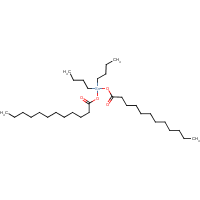Dibutyltin dilaurate
Agent Name
Dibutyltin dilaurate
CAS Number
77-58-7
Formula
C32-H64-O4-Sn
Major Category
Metals

Synonyms
Bis(lauroyloxy)di(n-butyl)stannane; Butynorate; Cata-Chek 820; DBTL; DXR 81; Davainex; Di-n-butyltin dilaurate; Dibutyl-tin-dilaurate; Dibutyl-zinn-dilaurat [German]; Dibutylbis(laurato)tin; Dibutylbis(lauroxy)stannane; Dibutylbis(lauroyloxy)tin; Dibutylstannium dilaurate; Dibutylstannylene dilaurate; Dibutyltin didodecanoate; Dibutyltin laurate; Dibutyltin n-dodecanoate; Fomrez sul-4; KS 20; Kosmos 19; Lankromark LT 173; Laudran di-n-butylcinicity [Czech]; Lauric acid, dibutylstannylene deriv.; Lauric acid, dibutylstannylene salt; Lauric acid, dibutyltin deriv.; Laustan-B; Mark 1038; Mark BT 11; Mark BT 18; Neostann U 100; Ongrostab BLTM; SM 2014C; Stabilizer D-22; Stanclere DBTL; Stannane, bis(dodecanoyloxy) di-n-butyl-; Stannane, bis(dodecanoyloxy)di-n-butyl; Stannane, bis(lauroyloxy)dibutyl-; Stannane, dibutylbis((1-oxododecyl)oxy)-; Stannane, dibutylbis(lauroyloxy)-; Stavincor 1200 SN; Stavinor 1200 SN; T 12; T 12 (VAN); T 12 (catalyst); TN 12; TN 12 (catalyst); TVS Tin Lau; TVS-TL 700; Therm chek 820; Thermolite T 12; Tin dibutyl dilaurate; Tin, di-n-butyl-, di(dodecanoate); Tin, dibutylbis(lauroyloxy)-; Tinostat; [ChemIDplus] UN2788 (liquid); UN3146 (solid);
Category
Tin Compounds, Organic
Description
Soft solid or yellow liquid; mp = 22-24 deg C; [Merck Index] Yellow oily liquid or waxy solid; [ICSC] Yellow viscous liquid; [MSDSonline]
Sources/Uses
Used as a stabilizer (polyvinyl chloride resins, vinyl resins, lacquers, and elastomers), a catalyst for urethane and silicones, and a drug (anthelmintic and coccidiostat); [HSDB]
Comments
An eye irritant; May cause injury to the liver, kidneys, and GI tract; [ICSC] Liver enzymes were elevated in rabbits fed 15-40 mg/kg for 6 weeks; Calves died with tremors, convulsions, weakness, and diarrhea after dibutyltin dilaurate was accidentally added to feed; Oral LD50 (rat) = 175 mg/kg (oil solution); [HSDB] A skin irritant; [CAMEO] An irritant; Can be absorbed through skin; [MSDSonline] See "Tin, organic compounds."
Biomedical References
Exposure Assessment
Skin Designation (ACGIH)
Yes
TLV (ACGIH)
0.1 mg/m3, as Sn
STEL (ACGIH)
0.2 mg/m3, as Sn
PEL (OSHA)
0.1 mg/m3, as Sn
MAK
0.02 mg/m3, inhalable fraction, as Sn
IDLH (NIOSH)
25 mg/m3, as Sn
Vapor Pressure
3E-10 mm Hg
Lethal Concentration
LC50 (rat) = 150 mg/m3/2h
Explanatory Notes
The Guide in the Emergency Response Guidebook is for "Organotin compound, liquid, n.o.s." Organic tin compounds have a "skin" designation and are classified as "A4" (Not classifiable as human carcinogen); [ACGIH]
Adverse Effects
Neurotoxin
Other CNS neurotoxin
Hepatotoxin
Hepatoxic (a) from occupational exposure (secondary effect) or (b) in animal studies or in humans after ingestion
ACGIH Carcinogen
Not Classifiable
Diseases, Processes, and Activities Linked to This Agent
Processes
Industrial Processes with risk of exposure: